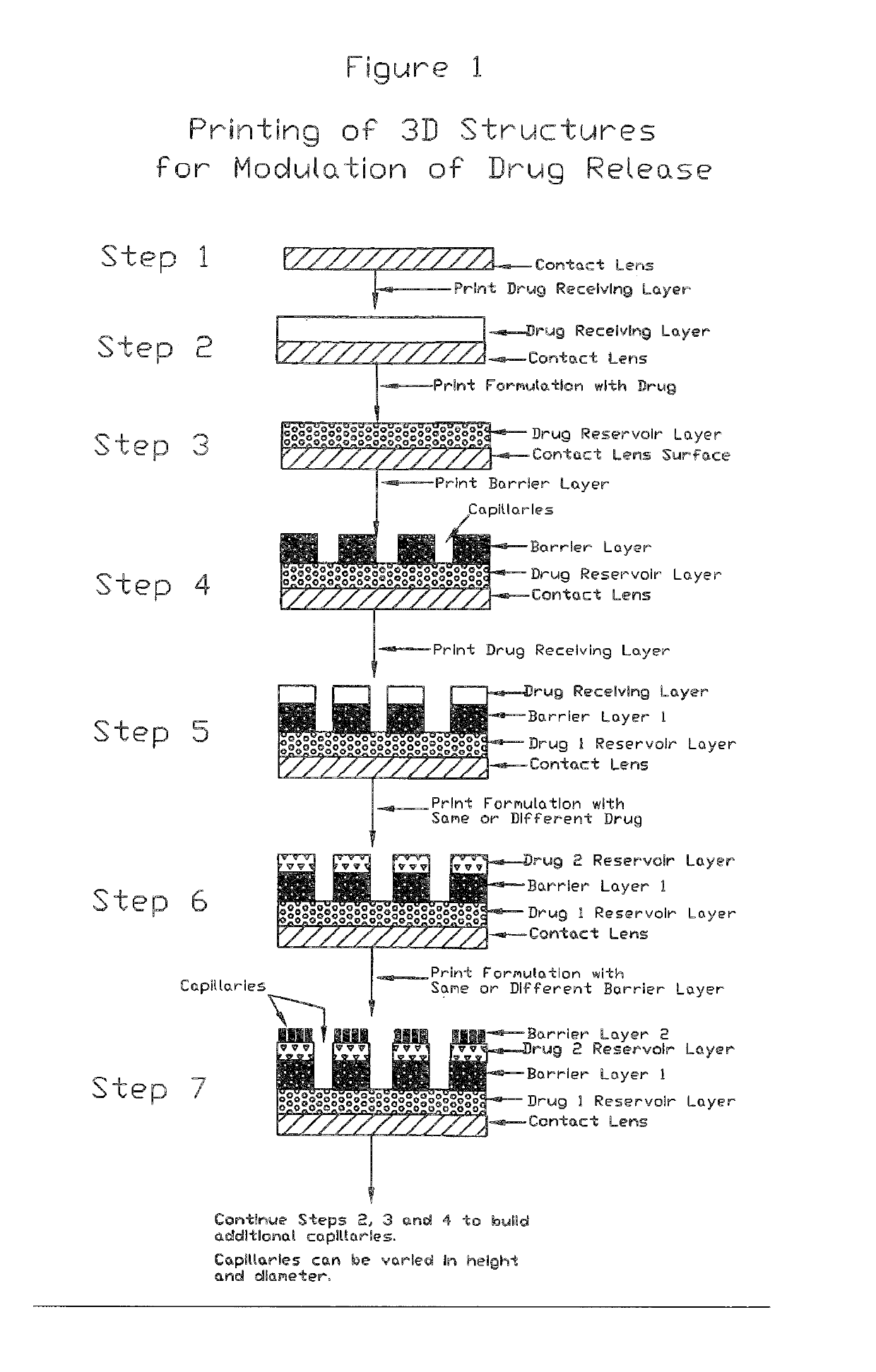Medical devices including medicaments and methods of making and using same including enhancing comfort, enhancing drug penetration, and treatment of myopia
a technology of medical devices and medicaments, applied in the field of medical devices, can solve the problems of affecting the optical properties of the lens, affecting the physical properties of the polymeric lens material, and not providing the desired dosage of a drug to the cornea or other areas of the eye structure and surrounding tissues,
- Summary
- Abstract
- Description
- Claims
- Application Information
AI Technical Summary
Benefits of technology
Problems solved by technology
Method used
Image
Examples
example # 1
Example #1
Preparation of Printable Formulation Using a Hydrophilic Drug
[0308]This example provides printable formulation with a drug used to inkjet print lenses.
[0309]The printable formulation include a base formulation that include the following: monomer (HEMA), initiator (BME), crosslinker (EGDMA), drug #1, diluent (glycerine), solvent (isopropanol), optional drug #2, dispersant (polyvinyl alcohol), humectant (ethylene glycol), co-monomer (methacrylic acid); inhibitor (MEHQ), antikogating agent (methyl propanediol), and antioxidant (alkylated hydroquinone). The concentration of these constituents are as appropriate for making a lens of desired characteristics and physical properties. Drug #1 and optional drug #2 can be any drug or combination of drugs to provide a desired activity.
[0310]A preferred monomer mixture for making a clear lenses coating has the following formulation: monomer (HEMA), monomer (EOEMA), monomer (MAA), crosslinker (EGDMA), initiator (Vazo-64), inhibitor (MEH...
example # 2
Example #2
[0312]This example provides a printing formulation with a solvent soluble drug used to inkjet print lenses.
[0313]A preferable formulation with a solvent soluble drug has the following composition and physical properties.
MaterialsMaterial TypePercentRangeDI WaterSolvent71.4760-80GlycerinSolvent6.67 1-201,3-propandiolSolvent6.67 1-20Water Soluble DrugDrug13.330.001-20 Surfynol CT 121Surfactant0.530.2-20 Triethyl Amine 10% in waterAdditive1.331-5Total100
Viscosity=3.5 centipoise, UL, 60 rpm, 25° C.
Surface tension=32 dynes / cm;
pH=8.4.
The formulation was filtered through 0.45 micron Nylon filter membrane.
Water=Main vehicle, carrier
Glycerin, 1,3-propandiol=co-solvents
Surfynol CT121 and 10% TEA solution=additive
[0314]The printable formation can also include a drug in encapsulated form. There are several methods available for encapsulation to meet the product performance requirements. These methods can be divided into 2 broad categories: (see, for example, South...
example # 3
Example #3
Preparation of an Oligomer Capable of Free Radical Polymerization for Use in Printable Formulations
[0336]A Poly hydroxy ethyl methacrylate prepolymer is prepared according to the following procedure. The following components are mixed:
Material%Methacrylic acid0.82%Mercaptoethanol0.70%Allyl methacrylate0.16%Ethyl triglycol methacrylate3.50%N-Vinyl pyrrolidinone6.07%2-Hydrozyethyl methacrylate35.42%Vazo 640.33%1-Ethoxy-2-propanol44.80%1-Methoxy-2-proply acetate8.21%
[0337]Thermal polymerization is carried out in a steel can fitted with an over head stirrer and mounted on a hot plate. The mixture is heated and temperature of the mixture is maintained at about 85° C. to about 90° C. by moving the can / stirrer assembly between cold water bath and the hot plate as necessary. The reaction is allowed to continue for about 37 minutes from initially reaching 85° C. prior to quenching polymerization by placing the can / stirrer assembly into the cold water bath. The cold prepolymer visco...
PUM
| Property | Measurement | Unit |
|---|---|---|
| Mass | aaaaa | aaaaa |
| Mass | aaaaa | aaaaa |
| Mass | aaaaa | aaaaa |
Abstract
Description
Claims
Application Information
 Login to View More
Login to View More - R&D
- Intellectual Property
- Life Sciences
- Materials
- Tech Scout
- Unparalleled Data Quality
- Higher Quality Content
- 60% Fewer Hallucinations
Browse by: Latest US Patents, China's latest patents, Technical Efficacy Thesaurus, Application Domain, Technology Topic, Popular Technical Reports.
© 2025 PatSnap. All rights reserved.Legal|Privacy policy|Modern Slavery Act Transparency Statement|Sitemap|About US| Contact US: help@patsnap.com



